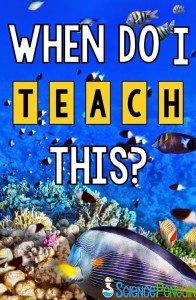
One of the most common questions I receive:
In what order do I teach these science concepts?
Thematic Teaching
I love combining standards as much as possible. However, with a pacing guide and state testing in 5th (not to mention retests until the end of the school year), combining topics to be more thematic can be difficult.
Here’s one idea for thematic teaching. Study the ocean. Experiment to see how sand doesn’t dissolve in water, but salt does dissolve. Study constant properties of water and relative density. Learn about the ocean’s role in the water cycle, tides, and weathering, erosion, and deposition. Study ocean plants and animals. Learn about their life cycles, traits, and adaptations.
While thematic teaching may not be an option for all of us, we can go in a particular order and still review other concepts in a thematic way. Also, you can do a culminating project at the end of the year to combine all the topics learned.
Sequential Planning for the Year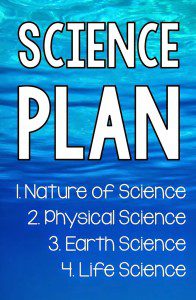
This is a tough post to write because I can’t write a plan for every grade level in every state. However, I can give you an overview of what has worked well for me.
I’ve always been provided with a pacing guide from my districts so I never really got to CHOOSE the order in which to teach the concepts. For the most part, the sequences provided made good sense, so I went with it. Here is the order I prefer.
1. Nature of Science
I like to get a head start on measurement tools, observations, and the scientific method before moving forward with new content. We reinforce and use these skills all year long, so a little introduction is great.
Safety
Tools
Scientific Communication
Scientific Method
Variables
2. Physical Science
I like moving to physical science next mainly because properties of matter will be something students use the rest of the school year, especially in earth science. Let’s be real here too. There is a lot of prep that goes into physical science lessons and I’m at my best in September so it’s better. It’s just better…
Properties of Matter
Constant Properties of Water
Mixtures, Solutions, and Compounds
Force and Motion
Forms of Energy
Light Energy
Thermal Energy
Electrical Energy
3. Earth Science
Earth science is nice for the middle of the year. These concepts can be a bit more dense and it’s helpful to be further into the year to begin earth science.
Natural Resources and Fossil Fuels
Alternative Energy Resources
Rocks and Fossils
Erosion
Water Cycle
Weather and Climate
Sun, Earth, and Moon
Cycles in Space
4. Life Science
I like ending with life science because it’s in spring, the time for life. This makes outdoor observations, plants, and ecosystems a lot easier. We typically spend less time on life science concepts, so it helps to end the year with it.
Plants
Ecosystems
Food Webs
Inherited Traits and Learned Behaviors
Adaptations
Life Cycles
Human Body
Sign up for the Free Resource Library
This is an exclusive library of 40+ science printables, labs, activities, and games for grades 3-6. Sign up and check your email for immediate access.

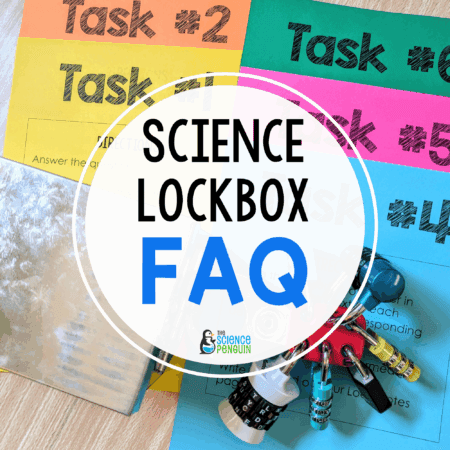
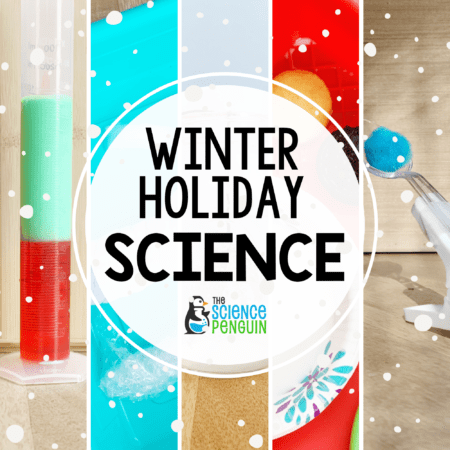
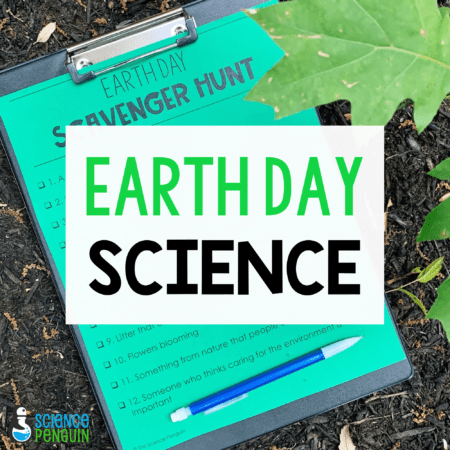

7 thoughts on “Science Solutions: Sequencing Guide”
Great post!!! Thank you so much for sharing you ideas 🙂
Julie
The Techie Teacher
I wish you had stuff like this for 6th grade Science and/or Social Studies. I LOVE your ideas and such, but a lot of it does not pertain in the 6th grade. Another side job for you? 🙂
The 5th grade science curriculum that I teach covers a large unit on human anatomy and body systems- do you have any resources on this topic? I would LOVE a science weekly 5 stations set on body systems! 🙂
Hi Tara. I have an Interactive Notebook resource and task cards for human body.
http://www.teacherspayteachers.com/Product/Human-Body-Interactive-Science-Notebook-1381770
http://www.teacherspayteachers.com/Product/Human-Body-Systems-Task-Cards-1559826
Thanks!
Ari
this is an awesome resource. thank you for sharing
Hi Ari,
What grade level is this relevant to? Do you have this for fourth?
It can also be used for 4th. 🙂